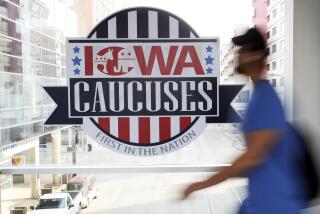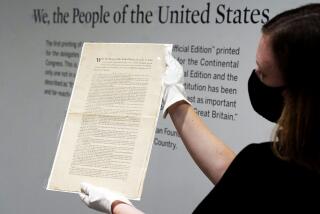Critic’s Notebook: Frank Lloyd Wright could be wrong for convention
Barack Obama had his Greek columns. Mitt Romney is turning to Frank Lloyd Wright.
When the Republican National Convention begins Monday inside the Tampa Bay Times Forum, a 19,500-seat arena in Tampa, Fla., that’s home during hockey season to the NHL’s Lightning, the stage will be crowded with large video screens framed in wood. Actually the “wood” will be made of vinyl and various laminates, but it’ll read on television as cherry, mahogany and walnut.
The inspiration for the set, said Jim Fenhagen, lead production designer for the convention, is Wright’s residential architecture, which often featured long horizontal bands of wood-framed windows.
The Wright references, which Fenhagen said he pulled together after a couple of simple Google searches, are relatively faint. They draw from the architect’s most approachable domestic designs — mostly the Prairie Style houses of his early career — rather than his most radical buildings. They’re more Oak Park than Fallingwater, more Robie House than Guggenheim Museum.
Still, in the context of a national political convention, where every symbolic choice is sure to be scrutinized, there are more than a few risks in going with Frank Lloyd Wright as your architectural touchstone. And I wonder how many of them the Romney campaign has fully considered.
For this particular ticket, the most obvious risk is the Ayn Rand connection. Wright was the chief inspiration for the headstrong architect Howard Roark, hero of Rand’s 1943 novel “The Fountainhead.” Romney’s running mate, Wisconsin Rep. Paul D. Ryan, was long a devotee of Rand’s Objectivist philosophy.
Ryan has done his best to move away from Rand in the last couple of years. Explaining her atheism and support for abortion, in particular, began to seem like more trouble than it was worth for a rising star in the 21st century GOP.
It was Wright’s stubborn sense of individualism that made him most attractive to Rand. She wrote the architect a string of fawning letters in the late 1930s, hoping to interview him as she was planning “The Fountainhead.”
“It is not anything definite or tangible that I want from an interview with you,” Rand wrote in one letter. “It is only the inspiration of seeing before me a living miracle.”
Wright rebuffed her initially, though they finally met and became friends after the novel was published. Rand and director King Vidor wanted Wright to design the sets for the movie version of “The Fountainhead,” but the job ultimately went to Edward Carrere.
Not that Wright was uninterested in how the movie would turn out. After the great designer George Nelson trashed the designs in Interiors in 1949, in an essay called “Mr. Roark Goes to Hollywood: A Comment on Warner Brothers’ Attempt to Interpret F. L. Wright to the Masses,” Wright sent a telegram to the magazine.
“Any move I would make against such grossly abusive caricature of my work by this film crew would only serve their purpose,” the telegram read. “They belie the one decent thesis of ‘The Fountainhead,’ the inalienable right of the individual to the integrity of his idea. It is best to laugh.”
Fenhagen said that Romney and his team approved the set design well before Ryan was picked as his running mate. But when Ryan steps behind the lectern to accept the vice presidential nomination next week, he’ll be sharing the stage with Rand’s ghost, a specter he has been trying to outrun for weeks.
As for Wright, let’s put it this way: He was no standard-bearer for conservative values. He grew his hair long and liked to wear a cape. His political views were far from consistent, but he leaned left and was accused of distrusting capitalism and even, on occasion, of having Communist ties.
Married three times, he scandalized Chicago society when he left his first wife to run off to Europe with Mamah Borthwick Cheney, who at the time was still married to one of Wright’s clients.
Wright and Cheney settled in rural Wisconsin. In 1914, while Wright was away on business in Chicago, a deranged servant set fire to their house — which newspaper tabloids had dubbed Wright’s “love bungalow” — and killed Cheney, her two children from her first marriage and four dinner guests.
You have to wonder if anybody on Romney’s staff has read Nancy Horan’s novel “Loving Frank,” which revolves around the Wright-Cheney love affair, or “The Fellowship,” a soap-operatic account by Roger Friedland and Harold Zellman of Wright’s years at Taliesin West in Arizona. Even Ada Louise Huxtable’s brief, incisive 2004 Penguin Lives biography would probably have been enough to suggest the choppy waters of Wrightian symbolism.
Romney’s team rejected an earlier version of the stage design — one without the Wright references — as too cold and detached, Fenhagen said. Just as Obama and the 2008 Democratic Convention used a neoclassical colonnade to bring the cavernous Invesco (now Sports Authority) Field in Denver down to manageable size, Romney wanted to humanize, and domesticate, the steel-and-glass architecture of the Tampa Bay Times Forum.
“A lot of the convention sets are these huge battleships — giant structures of power,” Fenhagen said. “We wanted something more approachable, so he could connect better with the audience. Romney does well in smaller, more intimate town-hall settings. This will be very warm, very contemporary, very American.”
Obama was criticized during the 2008 campaign by pundits who saw the Denver set as grandiose and self-important. More recently, Romney himself jumped into the act. Appearing on Fox News in April, he told Sean Hannity that when it comes to debt levels the U.S. is “moving toward the Greek-type numbers. My guess is, by the way, the Democratic Convention, [Obama] will not be appearing in front of Greek columns like in Denver. He won’t want to remind people of Greece.”
By venturing right into “Fountainhead” territory in Tampa, the Romney campaign is opening itself up to a critique of its own taste in architectural metaphor.
christopher.hawthorne@latimes.com
More to Read
The biggest entertainment stories
Get our big stories about Hollywood, film, television, music, arts, culture and more right in your inbox as soon as they publish.
You may occasionally receive promotional content from the Los Angeles Times.







